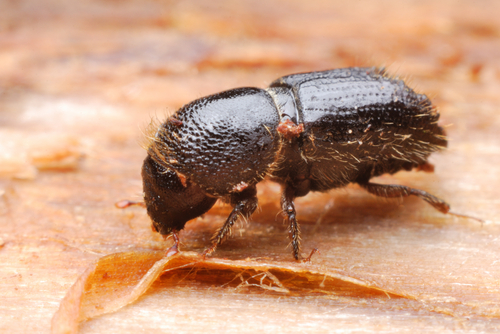Common Name: Bark Beetles
Sicentific Name: Various
Class/Order/Family: Insecta/Coleoptera/Scolytidae
Metamorphosis: Complete
Introduction
The common name comes from their dependence of the presence of bark on wood for their existence and survival. In homes, they are nuisance pests only because they cannot infest wood that has no bark or reinfest wood with dry bark. They are usually brought in with firewood. Various species occur throughout the United States and Canada, and worldwide.
Recognition
Depending on the species, adults about 1/64-3/8″ (0.6-9 mm, mostly 1-3 mm) long; body elongate-cylindrical. Color brown, reddish brown, or black. Head usually concealed from  above, narrower than pronotum. Antenna short, elbowed and nearly always clubbed, club abrupt, large, nearly round, and of 1-3 segments. Front of pronotum often bears teeth. Elytral apical area often concave, ridges sometimes armed with spine like teeth. Tarsi short, appearing 4-4-4 (5-5-5 with 4th segment minute).
above, narrower than pronotum. Antenna short, elbowed and nearly always clubbed, club abrupt, large, nearly round, and of 1-3 segments. Front of pronotum often bears teeth. Elytral apical area often concave, ridges sometimes armed with spine like teeth. Tarsi short, appearing 4-4-4 (5-5-5 with 4th segment minute).
Depending on the species, mature larvae about 1/16-3/8″ (2-10 mm) long; legless; body C-shaped, subcylindrical; and color usually white.
Similar Groups
(1) Pinhole borers or ambrosia beetles (Platypodidae) with head as wide as pronotum and tarsi very long with 1st segment longer than 2-5 combined.
(2) False powderpost beetles (Bostichidae) with antennal club asymmetrical, not rounded, and antenna not elbowed.
(3) Some deathwatch beetles (Anobiidae) with antennal club asymmetrical. or antenna saw-toothed/comblike, and antenna not elbowed.
Damages
Bark beetles do not cause damage to wood other than the slight cosmetic scoring/etching of the outer surface of the sapwood. There is no structural damage and they do not reinfest seasoned or barkless wood. Signs of infestation include piles o frass/sawdust below and around the outside entrance holes which go through the bark. If the bark is removed, the tunnels and galleries leave scoring on the surface of both the sapwood and inner bark.
Depending on the species, these scoring vary from completely random to a central tunnel with many lateral/side tunnels which resembles a large centipede in appearance. Adults each have their own round exit hole about 1/16-1/8″ (1.5-3 mm) in diameter. Emergence can look as if the tree was peppered with shot holes. Both live and recently killed hardwood and softwood trees are attacked/infested
Biology
Depending on the species, either the male or female bores the entrance tunnel through the bark to the cambium (layer of growing cells between the bark and sapwood). The adults excavate the brood galleries and the eggs are laid in the tiny side niches at intervals along the length of the gallery. The larvae tunnel out away from the egg gallery and tightly pack their tunnels with frass. As they molt, their tunnel size increases. Pupation tales place a the end of their tunnels. emerging adults tunnel directly/straight out through the bark. There are usually 1-5 generations per year.
Habits
See the Damage and Signs of Infestation and the Biology sections above. Adult beetles may emerge from exit holes in bark for up to one year after the tree is killed. In structures containing infested lumber with bark or logs with bark, emerging adults will be found at windows and/or lights because they are attracted to light. Log homes which still have bark on them for aesthetic reasons have the greatest potential for problems with emerging adults.
Bark beetles can be brought into the home in unseasoned firewood and emerge before it is burnt. In this case, they are a nuisance pest only and will not infest the wood in the house.
Control
No control measures are necessary because bark beetles do not infest seasoned wood. If the source is firewood, have it brought indoors just before burning. Firewood seasoned/dried for one year burns better and eliminates this potential problem in most cases.